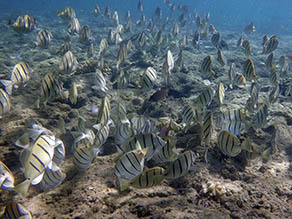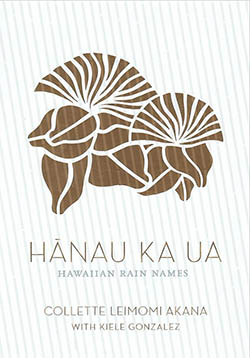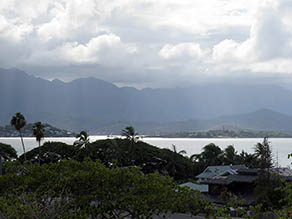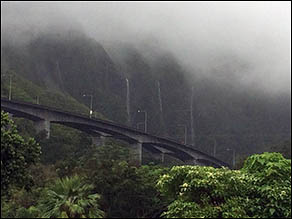 |
 |
 |
 |
||||||
|
|
|
|
|
|
|
|
|
|
|
| Areas | Seasons | Forest | Ocean | Sky | Language | Sources & Links | |||||||||
 |
|
 |
|||||||
 |
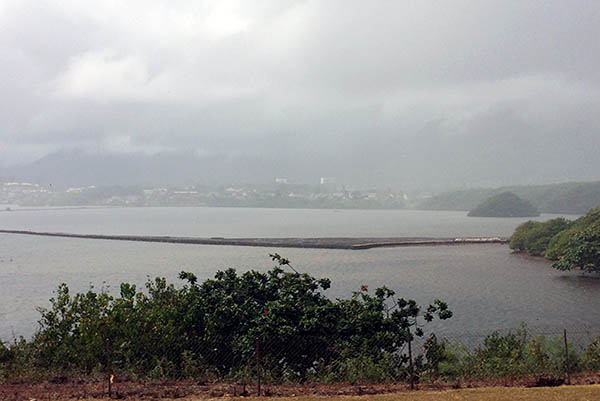
Seasons in the Hawaiian islands vary from place to place, so much so that the names for months on different islands differ. “I’ve seen calendars and the complexity for the five major islands,” Kalani says. “The month names differ, it’s not a uniform calendar. I’ve seen the printout, island by island for the five major islands and what the months are called and what order they are in, differ.” “I’d always laugh when people come in from another place telling us how to plant taro with their lunar cycle,” Kanekoa says, “when they have not taken the time to understand our lunar cycle here. Every land is different, every part of the island has different climates and different seasons. You might have ‘ulu season on this side of the island, and in Wai‘anae—which is beautiful—might have a completely different season for ulu. Every area has a little different lunar cycle.” “I think it empowers communities to know what we’ve always known,” Hi‘ilei adds, “which is we’re very much place-based. You cannot do in one place as you would do in another place. Seasons for this particular fish are not the same seasons that apply for this particular fish in this area. And so it tells us that we want to steward and take care of our resources, it really needs to be place-based. "Here’s the evidence to tell you that the manini are spawning now here in Kāne‘ohe Bay and might not be spawning elsewhere. So it really tells us that state rules and regulations, that sort of blanket approach to managing resources, doesn’t work. “I’m part of this ‘Aimalama team, so that’s kind of the work that we do is empowering community, teaching community to interpret their surroundings using kaulana mahina—our lunar calendar—as a tool to help facilitate and organize what it is we see.” Hi‘ilei explains the Hawaiian Lunar Calendar Watching the seasonal cycle in He‘eia.
“Kāne supplies us with water, fresh water. The god Kāne represents fresh water, sunlight, natural growth. Everything for the natural world to thrive. All of the natural world: forests and everything else. Lono, on the other hand, Lonoikamakahiki, Lono is the god of human efforts in horticulture. We can’t say 'agriculture.' Horticulture is like gardening, while agriculture is wide-scale farming. So this is horticulture, they were gardeners. Human activity, what we can earn or have the Earth produce, is what we owe Lono for the success of our endeavors. And so we honor him during the Makahiki season, that period of three to four months in celebration of the harvest. It is a long 'harvest festival,' you can say. 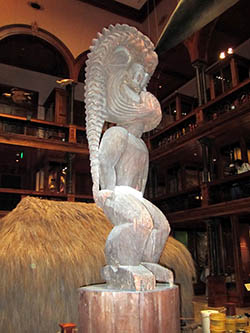
“We honor him and warfare is forbidden during that period of the year. The closing of the Makahiki coincided, of all things, with the time of Captain Cook’s passing—February fourteenth, Valentine’s Day in 1779. And then warfare resumed. That was the period of Kū, the god of war, which also including human sacrifice. “And of course the fourth god is the least important for Hawaiians: Kanaloa, the god of the ocean. He’s the least in the consciousness of the Hawaiians except for males because Kanaloa and Kū both have a lot to do with male activities like fishing, farming, canoe building. It’s an interesting, complex world really.” “Hawaiians were so acute with their understanding of nature,” Ian points out, “and the subtleties of not only nature in general. Science is so macro but micro. The way that we look at it is mythology of the landscape, because it really supports the natural science with the specifics about each place. It’s not just a wind. It’s not just a rain. It has a character. It has a place, a home, and the people of that place love or fear that character and respect it all around but know it. They know it because there was just not one god. There was one god, and the four gods, and gods, goddesses, deities, and 40 deities. 400, 4,000, 40,000, 400,000 deities presiding over all aspects of nature, each with name and character, nā kini akua.”
Ian goes on to tell of the rains in this part of Ko‘olaupoko: 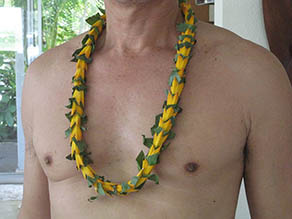
“He‘eia is the Kālepa, the coral-shattering rain of He‘eia that run up and get the boots wet, the Hō‘ilo [winter, stormy season] rain when you’re up there picking the ferns in the back.” In her 2017 book, The Power of the Steel-Tipped Pen: Reconstructing Native Hawaiian Intellectual History, Noenoe Silva tells of a kānaenae, “a chant of affection that Hiiaka offers when she is standing atop Mahinui in Kailua observing the wahi pana and people around her. She looks at He‘eia to the northwest and sees a group of women travling to the uplands of ‘Āhuimanu to make lei from hala fruit.”
Noenoe adds that Hi‘iaka always sings to the ‘āina as she goes along. “Various places, which/who speak and act, will be insulted or hurt if she doesn’t recognize them. She, in turn, demands recognition and hospitality from both these divine characters who are landforms and so forth, and humans. Mutual recognition and hospitality to travelers are central values of Hawaiian culture, as is often seen in the oral tradition.” Similarly, Akana, in her book Hānau ka Ua —Hawaiian Rain Names, translates a letter describing Quen Kapi‘olani’s journey from Honolulu to Ko‘olau, clearly drawing on the above chant( Akana p. 47):
“‘Āpuakea is the rain that’s Waimānalo and Kailua,” Ian continues, “runs up into Luluku in Kāne‘ohe. And then on this side, we have the Ulumano ['blowing hard'] rain because Moku Manu was the home of the shark god, Kūha‘imoana. And so that pass between the island of Moku Manu and Mōkapu Point was known as Kawahookamānō, which is the mouth of the shark.
“Ulu also means ‘growth’ so it may be the point where the rains grow, but I start to wonder if it’s Ulumano with that relationship to the shark, and how it comes through this pass. Because the other rains over there, this one comes in this side and sweeps across here, and then goes up and goes into the Kālepa rain. “That looks like the Holopali rain,” Ian points from Mōkapu towards the mountains of Kualoa, “the wind and rain that ‘runs along the cliff’ [holo pali] from Kualoa to Ka‘a‘awa. Because either way you go, it splits and runs along the cliff. Each rain had a name. “Across the peninsula it goes up to the whole Hō‘ilo right up there. This one goes into the back. But then you have the Kauapō‘aihale for Kahalu‘u because that whole Waihee-Kahalu‘u area, the rain swirls around, gets caught in that whole area. And then you have the Kiliua, the white rain of Waikāne and Waiahole.” In Archaeology of O‘ahu, McAllister wrote of Kauapo‘aihale o Kahalu‘u, “This is the region known by old Hawaiians as Kauapo‘aihale o Kahalu‘u because the rain circles round and round the hills and never goes beyond Kahaluu.” In Sites of O‘ahu, page 194. “Now in Hakipu‘u,” Ian goes on, “this is it not a named rain, but Keoki Fukumitsu’s family says great, great grandma called it the Kēhau, which is the convective mist and light rain that comes down off the mountain in the morning, that was the menehune, that was the Lono, the kēhau mist, the kēhau lani, the tears from heaven.” Akana also presents the following additional rain names for He‘eia: Kaniko‘o: refers to the tapping sound of a cane
Līpoa: Same as Uaakalīpoa, also the name of a seaweed:
This chant comes from the legend of Kamaakamahi‘ai, recited by Kahelekūlani of He‘eia as she left her husband,m Waikūmailani, who had found another women. Source: Kaualilinoe, “Ka moolelo,” 11/5/1870. (Akana, 163-4). Akana also lists Ki‘owao as a rain for He‘eia. According to Pukui and Elbert’s Hawaiian dictionary, this is a “cool mountain rain accompanied by wind and fog.” “Wind and rain names go together here,” Ian remarks. Like everything else, it’s relational and genealogical. If you want to talk about it in general, it’s nāulu [“shower clouds”].
|
 |
|||
 |
The variations in rainfall within He‘eia itself makes for different vegetation and forest zones.
|
 |
||
 |
|
 |
||

|
 |
||||
|
||||
Copyright 2019 Pacific Worlds & Associates • Usage Policy • Webmaster |
||||
